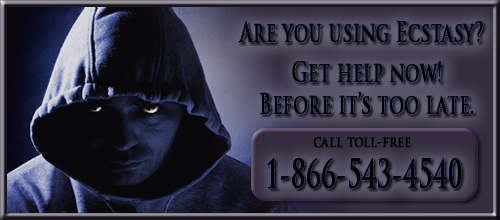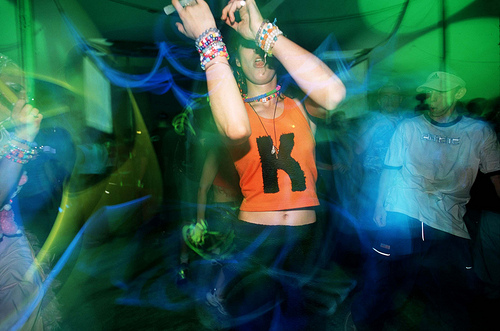Ecstasy Abuse

Ecstasy Abuse
 In addition to chemical stimulation, ecstasy abuse suppresses the need to eat, drink, or sleep. When taken at raves, where all-night dancing usually occurs, the drug often leads to severe dehydration. Abuse of this drug may also cause heat stroke in the user since it has the effect of "short-circuiting" the body's temperature signals to the brain. An ecstasy abuse overdose is characterized by a rapid heartbeat, high blood pressure, faintness, muscle cramping, panic attacks, and, in more severe cases, loss of consciousness or seizures. One common ecstasy abuse side effect is jaw muscle tension and teeth grinding. As a consequence, ecstasy users will often suck on pacifiers to help relieve the tension. Ecstasy abuse may cause hypothermia, muscle breakdown, seizures, stroke, kidney and cardiovascular system failure, possible permanent damage to sections of brain critical to thought and memory, and death.
In addition to chemical stimulation, ecstasy abuse suppresses the need to eat, drink, or sleep. When taken at raves, where all-night dancing usually occurs, the drug often leads to severe dehydration. Abuse of this drug may also cause heat stroke in the user since it has the effect of "short-circuiting" the body's temperature signals to the brain. An ecstasy abuse overdose is characterized by a rapid heartbeat, high blood pressure, faintness, muscle cramping, panic attacks, and, in more severe cases, loss of consciousness or seizures. One common ecstasy abuse side effect is jaw muscle tension and teeth grinding. As a consequence, ecstasy users will often suck on pacifiers to help relieve the tension. Ecstasy abuse may cause hypothermia, muscle breakdown, seizures, stroke, kidney and cardiovascular system failure, possible permanent damage to sections of brain critical to thought and memory, and death.
Ecstasy (MDMA= 3, 4-methylenedioxymethamphetamine) is a synthetic, psychoactive drug chemically similar to the stimulant methamphetamine and the hallucinogen mescaline. MDMA is an illegal drug that acts as both a stimulant and psychedelic, producing an energizing effect, as well as distortions in time and perception and enhanced enjoyment from tactile experiences.
In high doses, ecstasy abuse can interfere with the body's ability to regulate temperature. On rare but unpredictable occasions, this can lead to a sharp increase in body temperature (hypothermia), resulting in liver, kidney, and cardiovascular system failure, and death. Because ecstasy abuse can interfere with the users metabolism (breakdown within the body), potentially harmful levels of the drug can be reached by repeated drug use within short intervals.
Users of ecstasy face many of the same risks as users of other stimulants such as cocaine and amphetamines. These include increases in heart rate and blood pressure, a special risk for people with circulatory problems or heart disease, and other symptoms such as muscle tension, involuntary teeth clenching, nausea, blurred vision, faintness, and chills or sweating.
Ecstasy abuse is often found in adolescents and young adults who use it to promote euphoria, feelings of closeness, empathy, sexuality and to reduce inhibitions. It is considered a "party drug" and obtained at "rave" or "techno" parties. However, its abuse has expanded, to include other settings outside of the rave scenes, such as a college campus.
Among students surveyed as part of the 2005 Monitoring the Future study, 2.8% of eighth graders, 4.0% of tenth graders, and 5.4% of twelfth graders reported ecstasy abuse at one point or another in their lives. In 2004, these percentages were 2.8%, 4.3%, and 7.5%, respectively.
Forty percent of eighth graders, 51.4% of tenth graders, and 60.1% of twelfth graders surveyed in 2005 reported that trying MDMA once or twice was a "great risk." The Youth Risk Behavior Surveillance (YRBS) study by the Centers for Disease Control and Prevention (CDC) surveys high school students on several risk factors including drug and alcohol use. Results of the 2005 survey indicate that 6.3% of high school students reported ecstasy abuse at some point in their lifetimes. This is down from 11.1% in 2003.
Although MDMA is known universally among users as ecstasy, researchers have determined that many ecstasy tablets contain not only MDMA but also a number of other drugs or drug combinations that can be harmful as well. Adulterants found in MDMA tablets purchased on the street include methamphetamine, caffeine, the over-the-counter cough suppressant dextromethorphan, the diet drug ephedrine, and cocaine. Also, as with many other drugs of abuse, MDMA is rarely used alone. It is not uncommon for users to mix MDMA with other substances, such as LSD (acid) and marijuana.
